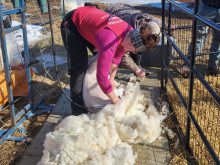There’s a heifer in your future if that’s what you want.
By 2008, Canadian cattle and swine producers will be able to select the sex of their animals’ offspring when purchasing semen straws, said Bill Gastle.
The entrepreneurial researcher who heads Toronto’s Microbix Biosystems Inc. feels the affordable technology will be a breakthrough.
“If you are a dairy farmer then you don’t want bull calves. If you are a beef producer, no females. Unless you need them. You can choose,” he said.
“We think this is one of the biggest developments in the breeding industry since artificial insemination was developed for livestock 50 years ago.”
Read Also

Charges laid after cattle theft
Saskatchewan RCMP lay two charges against a man after six cattle went missing.
Techniques for sexing sperm have been under development since the 1970s with various claims of success. However, commercialization of the process has been limited.
A few companies, none in Canada, have licensed the original process that involves the use of a flow cytometer, a computerized tool that can sort dyed sperm cells by the amount of DNA they contain. Males have 3.8 percent more due to the extra chromosome.
Gastle said the Microbix technology originally developed at the University of Guelph in Ontario could be used in existing semen production.
Microbix claims greater than 90 percent accuracy for the testing and sorting process that is patented in the United States and European Union.
“It should be relatively low cost. We understand what narrow margins producers work with and with this technology, we feel they should be able to increase those margins a bit,” he said.
Because the semen analysis is done by seeking out the XX (female) or XY (male) chromosomes, and physically separating them, the technique doesn’t require government approval.
“Even so, we are still working to commercialize the technique and that will take some time,” said Gastle.
Sandy Russell, a Saskatchewan government beef economist, said the cost savings to beef and dairy producers could be substantial.
“Beef producers are pretty entrepreneurial. If this catches on, they will find ways to maximize their returns with it,” she said.
Colin Palmer, who teaches at the Western College of Veterinary Medicine in Saskatoon, said, “the commercial beef industry is only using AI about 15 percent of the time.
There would be a cost for sexing and AI, so it may take some time for producers to begin adopting the technology.
“But dairy is already hooked on AI and there it will be big. Bull calves are not generally a profitable part of that business,” said Palmer.
Russell said making sex selection possible would work well for those beef producers willing to use AI and who want to specialize in commercial replacement heifers or some other specific need.
Dairy producers could plan their dairy bull semen inseminations to create just the right portion of heifers for sale or replacement, while breeding the remainder of a milking herd to high performance.
















